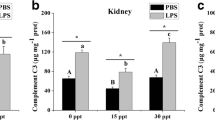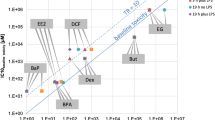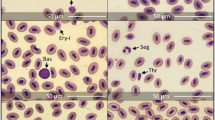Abstract
We evaluated the direct effects of in vitro exposures to tributyltin (TBT), a widely used biocide, on the cell-mediated immune system of Chinook salmon (Oncorhynchus tshawytscha). Splenic and pronephric leukocytes isolated from juvenile Chinook salmon were exposed to TBT (0, 0.1, 0.2, 0.3, 0.4, 0.5, and 0.6 mg/l) in cell cultures for 24 h. Effects of TBT on cell viability, induction of apoptosis, and mitogenic responses were measured by flow cytometry. Splenic and pronephric leukocytes in the presence of TBT experienced a concentration-dependent decrease in viability in cell cultures. Apoptosis was detected as one of the mechanisms of cell death after TBT exposure. In addition, pronephric lymphocytes exhibited a greater sensitivity to TBT exposure than pronephric granulocytes. The functional ability of splenic B-cells to undergo blastogenesis upon lipopolysaccharide stimulation was also significantly inhibited in the presence of 0.05, 0.07, or 0.10 mg/l of TBT in the cell cultures. Flow cytometric assay using a fluorescent conjugated monoclonal antibody against salmon surface immunoglobulin was employed for the conclusive identification of B-cells in the Chinook salmon leukocytes. Our findings suggest that adverse effects of TBT on the function or development of fish immune systems could lead to an increase in disease susceptibility and its subsequent ecological implications.




Similar content being viewed by others
References
Abelli L, Baldassini MR, Meschini R, Mastrolia L (1998) Apoptosis of thymocytes in developing sea bass Dicentrarchus labrax (L.). Fish Shellfish Immunol 8:13–24
Alison MR, Sarraf CE (1995) Apoptosis: regulation and relevance to toxicology. Hum Exp Toxicol 14:355–362
Anderson DP, van Muiswinkel WB, Roberson BS (1984) Effects of chemically induced immune modulation on infectious diseases of fish. Prog Clin Biol Res 161:187–211
Arkoosh MR, Clemons E, Huffman P, Sanborn HR, Casillas E, Stein JE (1996) Leukoproliferative response of splenocytes from English sole (Pleuronectes vetulus) exposed to chemical contaminants. Environ Toxicol Chem 15:1154–1162
Arkoosh MR, Clemons E, Huffman P et al (2001) Increased susceptibility of juvenile chinook salmon to vibriosis after exposure to chlorinated and aromatic compounds found in contaminated urban estuaries. J Aquat Anim Health 13:257–268
Axiak V, Vella AJ, Agius D et al (2000) Evaluation of environmental levels and biological impact of TBT in Malta (Central Mediterranean). Sci Total Environ 258:89–97
Berto D, Giani M, Boscolo R et al (2007) Organotins (TBT and DBT) in water, sediments, and gastropods of the southern Venice lagoon (Italy). Marine Pollut Bull 55:425–435
Byrne A, Reen DJ (2002) Lipopolysacharide induces rapid production of IL-10 by monocytes in the presence of apoptotic neutrophils. J Immunol 8:1968–1997
Carlson EA, Li Y, Zelikoff JT (2002) Exposure of Japanese medaka (Oryzias latipes) to benzo[a]pyrene suppresses immune function and host resistance against bacterial challenge. Aquat Toxicol 56:289–301
Champ MA (2000) A review of organotin regulatory strategies, pending actions, related costs and benefits. Sci Total Environ 258:21–71
Chau YK, Maguire RJ, Brown M, Yang F, Batchelor SP (1997) Occurrence of organotin compounds in the canadian aquatic environment five years after the regulation of antifouling uses of tributyltin. Water Qual Res Canada 32:453–521
Crippen TL, Bootland LM, Leong JC, Fitzpatrick MS, Schreck CB, Vella AT (2001) Analysis of salmonid leukocytes purified by hypotonic lysis of erythrocytes. J Aquat Anim Health 13:234–245
Fadok VA, Bratton DL, Freed PW, Westcott JY, Henson PM (1998) Macrophages that have ingested apoptotic cells in vitro inhibit proinflammatory cytokine production trough autocrine/paracrine mechanisms involving TGF-β1, PGE2 and PAF. J Clin Invest 101:890–898
Faisal M, Marzouk MS, Smith CL, Huggett RJ (1991) Mitogen induced proliferative responses of lymphocytes from spot (Leiostomus xanthurus) exposed to polycyclic aromatic hydrocarbon contaminated environments. Immunopharmacol Immunotoxicol 13:311–327
Fent K (1996) Ecotoxicology of organotin compounds. Crit Rev Toxicol 26:1–117
Gratiot-Deans J, Merino R, Nunez G, Turka LA (1994) Bcl-2 expression during T-cell development: early loss and late return occur at specific stages of commitment to differentiation and survival. Proc Natl Acad Sci USA 91:10,685–10,689
Grinwis GC, Vethaak AD, Wester PW, Vos JG (2000) Toxicology of environmental chemicals in the flounder (Platichthys flesus) with emphasis on the immune system: field, semi-field (mesocosm) and laboratory studies. Toxicol Lett 112–113:289–301
Harford AJ, O’Halloran K, Wright PFA (2005) The effects of in vitro pesticide exposures on the phagocytic function of four native Australian freshwater fish. Aquat Toxicol 75:330–342
Harford AJ, O’Halloran K, Wright PFA (2007) Effect of in vitro and in vivo organotin exposures on the immune functions of murray cod (Maccullochella peeliipeelii). Environ Toxicol Chem 26:1649–1656
Inohara N, Nunez G (2000) Genes with homology to mammalian apoptosis regulators identified in zebrafish. Cell Death Differ 7:509–510
Janeway CA, Travers P, Walport M, Capra JD (1999) Immunobiology: the immune system in health and disease, 4th edn. Current Biology Ltd., London/Garland Publishing, New York
Kannan K, Falandysz J (1997) Butyltin residues in sediment, fish, fish-eating birds, harbour porpoise and human tissues from the polish coast of the Baltic Sea. Marine Pollut Bull 34:203–207
Krajnc EI, Wester PW, Loeber JG et al (1984) Toxicity of bis(tri-n-butyltin)oxide in the rat. I. Short-term effects on general parameters and on the endocrine and lymphoid systems. Toxicol Appl Pharmacol 75:363–386
Kratz E, Eimon PM, Mukhyala K et al (2006) Functional characterization of the Bcl-2 gene family in the zebrafish. Cell Death Differ 13:1631–1640
Krone CA, Stein JE, Varanasi U (1996) Butyltin contamination of sediments and benthic fish from the east, Gulf and Pacific coasts of the United States. Environ Monitor Assess 40:75–89
Lee CC, Hsieh CY, Tien CJ (2006) Factors influencing organotin distribution in different marine environmental compartments, and their potential health risk. Chemosphere 65:547–559
Liu HG, Wang Y, Lian L, Xu LH (2006) Tributyltin induces DNA damage as well as oxidative damage in rats. Environ Toxicol 21:166–171
Lu L, Osmond DG (2000) Apoptosis and its modulation during B lymphopoiesis in mouse bone marrow. Immunol Rev 175:158–174
Matthiessen P, Gibbs PE (1998) Critical appraisal of the evidence for tributyltin-mediated endocrine disruption in mollusks. Environ Toxicol Chem 17:37–43
McCain B (1991) Center scientists investigate chemical contamination and associated fish diseases in San Diego Bay. NorthWest Fisheries Science Center (NWFSC) Quarterly Report Jan–Mar, pp 1–6
Mee LD, Fowler SW (1991) Organotins biocides in the marine environment: a managed transient? Marine Environ Res 32:89–111
Meister A, Anderson ME (1983) Glutathione. Annu Rev Biochem 52:711–760
Merino R, Ding L, Veis DJ, Korsmeyer SJ, Nunez G (1994) Developmental regulation of the Bcl-2 protein and susceptibility to cell death in B lymphocytes. EMBO J 13:683–691
Michel P, Averty B, Andral B, Chiffoleau JF, Calgani F (2001) Tributyltin along the coasts of Corsica (Western Mediterranean): a persistent problem. Marine Pollut Bull 42:1128–1132
Miller NW, Mc Kinney EC (1994) In vitro culture of fish leukocytes. In: Hocachka PW, Mommsen TP (eds) Biochemistry and molecular biology of fishes, vol 3. Elsevier, Amsterdam, pp 341–353
Milston RH, Vella AT, Crippen TL, Fitzpatrick MS, Leong JC, Schreck CB (2003) In vitro detection of functional humoral immunocompetence in juvenile chinook salmon (Oncorhynchus tshawytscha) using flow cytometry. Fish Shellfish Immunol 15:145–158
Misumi I (2003) Effects of exposures to anthropogenic pollutants on the immune system of chinook salmon (Oncorhynchus tshawytscha). Master’s thesis, Oregon State University, Seattle
Misumi I, Vella AT, Leong JC, Nakanishi T, Schreck CB (2005) p,p′-DDE depresses the immune competence of chinook salmon (Oncorhynchus tshawytscha) leukocytes. Fish Shellfish Immunol 19:97–114
Nakata H, Sakakibara A, Kanoh M et al (2002) Evaluation of mitogen-induced responses in marine mammal and human lymphocytes by in vitro exposure of butyltins and non-ortho coplanar PCBs. Environ Pollut 120:245–253
Nakayama A, Kurokawa Y, Harino H et al (2007) Effects of tributyltin on the immune system of Japanese flounder (Paralichthys olivaceus). Aquat Toxicol 83:126–133
O’Halloran K, Ahokas JT, Wright PFA (1998) Response of fish immune cells to in vitro organotin exposures. Aquat Toxicol 40:141–156
Ohji M, Arai T, Miyazaki N (2006) Differences of tributyltin accumulation on the masu salmon Oncorhynchus masou between sea-run and fresh water resident types. J Fish Biol 68:931–939
Okada Y, Oyama Y, Chikahisa L et al (2000) Tri-n-butyltin-induced change incellular level of glutathione in rat thymocytes: a flow cytometricstudy. Toxicol Lett 117:123–128
Osborne BA, Smith SW, Liu ZG, McLaughlin KA, Grimm L, Schwartz LM (1994) Identification of genes induced during apoptosis in T lymphocytes. Immunol Rev 142:301–320
Raffray M, Cohen GM (1993) Thymocyte apoptosis as a mechanism for tributyltin-induced thymic atrophy in vivo. Arch Toxicol 67:231–236
Rice CD, Banes MM, Ardelt TC (1995) Immunotoxicity in channel catfish, Ictalurus punctatus, following acute exposure to tributyltin. Arch Environ Contam Toxicol 28:464–470
Schwaiger J, Bucher F, Ferling H, Kalbfus W, Negele RD (1992) A prolonged toxicity study on the effects of sublethal concentrations of bis(tri-n-butyl-tin)oxide (TBTO): histopathological and histochemical findings in rainbow trout (Oncorhynchus mykiss). Aquat Toxicol 23:31–48
Schwaiger J, Falk HF, Bucher F, Orthuber G, Hoffmann R, Negele RD (1994) Prolonged exposure of rainbow trout (Oncorhynchus mykiss) to sublethal concentrations of bis(tri-n-butyltin)oxide: effects on leucocytes, lymphatic tissues and phagocytosis activity. In: Muller R, Lloyd R (eds) Sublethal and chronic effects of pollutants on freshwater fish. Blackwell Scientific, Cambridge, MA, pp 113
Short JW, Thrower FP (1986) Tri-n-butyltin caused mortality of Chinook salmon, Oncorhynchus tshawytscha, on transfer to a TBT-treated marine net pen. Oceans ‘86 conference record, vol 4. Organotin Symposium. IEEE Publ Service, New York, pp 1202–1205
Strand J, Jacobsen JA (2005) Accumulation and trophic transfer of organotins in a marine food web from the Danish coastal waters. Sci Total Environ 350:72–85
Sumpter JP (1998) Xenoendorine disrupters: environmental impacts. Toxicol Lett 102–103:337–342
Tada-Oikawa S, Kato T, Kuribayashi K, Nishino K, Murata M, Kawanishi S (2008) Critical role of hydrogen peroxide in the differential susceptibility of Th1 and Th2 cells to tributyltin-induced apoptosis. Biochem Pharmacol 75:552–561
Umebayashi C, Oyama Y, Chikahisa-Muramatsu L et al (2004) Tri-n-butyltin-induced cytotoxicity on rat thymocytes in presence and absence of serum. Toxicol In Vitro 18:55–61
Viglino L, Pelletier E, St-Louis R (2004) Highly persistent butyltins in northern marine sediments: a long-term threat for the Saguenay Fjord (Canada). Environ Toxicol Chem 23:2673–2681
Watermann B, Kranz H (1992) Pollution and fish diseases in the North Sea: some historical aspects. Marine Pollut Bull 23:131–138
Wester PW, Canton JH (1987) Histopathological study of Poecilia reticulata (guppy) after long-term exposure to bis(tri-n-butyltin)oxide (TBTO) and di-n-butyltindichloride (DBTC). Aquat Toxicol 10:143–165
Weyts FAA, Verburg-van Kemenade BML, Flik G, Lambert JGD, Wendelaar B (1997) Conservation of apoptosis as an immune regulatory mechanism: effects of cortisol and cortisone on carp lymphocytes. Brain Behav Immun 11:95–105
Yasutake WT, Wales JH (1983) Microscopic anatomy of salmonids: an atlas. United States Department of the Interior, Fish and Wildlife Service, Washington, DC, p 150
Acknowledgments
We are grateful to Beth Siddens for managing the laboratory and helping us out with our sampling. We thank Rob Chitwood, manager of the Fish Performance and Genetics Laboratory at Oregon State University for his assistance with establishing the experimental conditions and Dr. Grant Feist for his guidance with data analysis. The research was supported by a grant from Oregon Sea Grant and funds from the Hawai’i Institute of Marine Biology.
Author information
Authors and Affiliations
Corresponding author
Rights and permissions
About this article
Cite this article
Misumi, I., Yada, T., Leong, JA.C. et al. The Effect of In Vitro Exposure to Tributyltin on the Immune Competence of Chinook Salmon (Oncorhynchus tshawytscha) Leukocytes. Arch Environ Contam Toxicol 56, 229–237 (2009). https://doi.org/10.1007/s00244-008-9187-5
Received:
Accepted:
Published:
Issue Date:
DOI: https://doi.org/10.1007/s00244-008-9187-5




